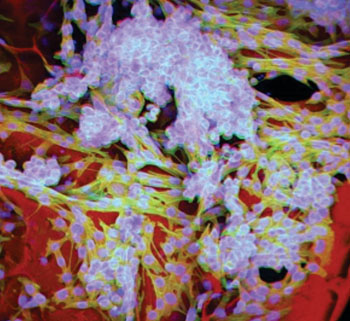Mouse Model Shows Potential of Personalized Cancer Treatment Based on Live Cell Vaccination
By LabMedica International staff writers
Posted on 09 Sep 2015
A novel personalized approach to cancer immunotherapy is based on sponge-like "cryogels" that are loaded with a sampling of the patient's tumor cells together with immune system-stimulating reagents and then injected under the skin.Posted on 09 Sep 2015
Cryogels are a type of hydrogel made up of cross-linked hydrophilic polymer chains that can hold up to 99% water. They are created by freezing a solution of the polymer during the gelling process. When thawed to room temperature, the substance turns into a highly interconnected pore-containing hydrogel, which is similar in composition to bodily soft tissues in terms of their water content, structure, and mechanics.

Image: Cancerous melanoma cells, shown with their cell bodies (green) and nuclei (blue), are nestled in tiny hollow lumens within the polymeric cryogel (red) structure (Photo courtesy of the Wyss Institute at Harvard University).
Investigators at Harvard University (Cambridge, MA, USA) worked with a mouse melanoma model. They injected some of these animals with sponge-like macroporous cryogels that had been loaded with GM-CSF (granulocyte macrophage colony-stimulating factor), serving as a DC (dendritic cell) enhancement factor. GM-CSF is a cytokine that functions as a white blood cell growth factor. GM-CSF stimulates stem cells to produce granulocytes (neutrophils, eosinophils, and basophils) and monocytes. Monocytes exit the circulation and migrate into tissue, whereupon they mature into macrophages and dendritic cells. Thus, it is part of the immune/inflammatory cascade, by which activation of a small number of macrophages can rapidly lead to an increase in their numbers, a process crucial for fighting infection.
In addition to GM-CSF, the cryogels were loaded with CpG ODN (CpG oligodeoxynucleotide, a molecule with immunostimulatory properties) that served as a DC activating factor and with a number of cancer cells harvested from the same mouse. These cryogels were injected subcutaneously into the mice to localize transplanted tumor cells and deliver immunomodulatory factors in a controlled spatiotemporal manner.
Results published in the August 12, 2015, online edition of the journal Nature Communications revealed that these vaccines elicited local infiltrates composed of conventional and plasmacytoid DCs, with the subsequent induction of potent, durable, and specific anti-tumor T-cell responses in the melanoma model. These responses induced tumors to shrink and even provided prophylactic protection from tumor growth. Cryogels could be delivered in a minimally invasive manner, bypassed the need for genetic modification of transplanted cancer cells and provided sustained release of immunomodulators.
"Instead of genetically engineering the cancer cells to influence the behavior of immune cells, we use immune-stimulating chemicals or biological molecules inserted alongside harvested cancer cells in the porous, sponge-like spaces of the cryogel vaccine," said senior author Dr. David Mooney, professor of bioengineering at Harvard University.
Related Links:
Harvard University













